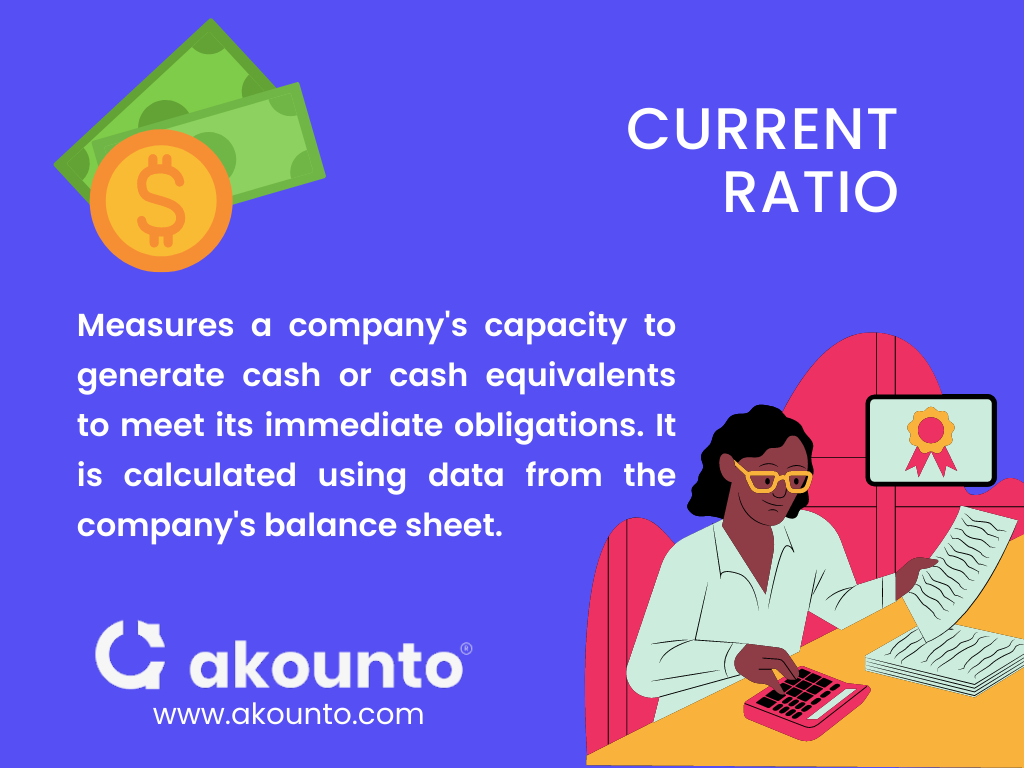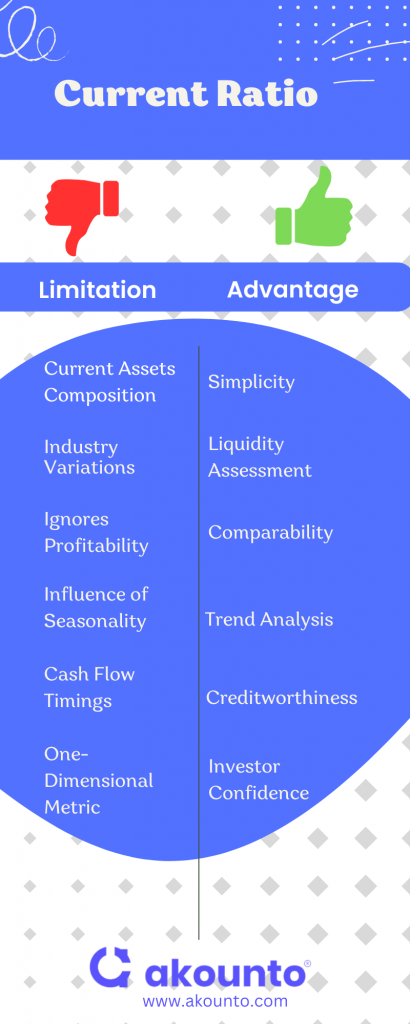The current ratio in financial accounting measures the company’s ability to pay for its short-term loans or obligations that arise within a year. The current ratio is also called the working capital ratio, and it is a part of liquidity ratios.
The current ratio measures the short-term liquidity of a company. For short-term liquidity, we can say that are current assets enough to pay for current liabilities.
[ez-toc]
Understanding Current Ratio

Unable to meet current liabilities hampers the functioning of business operations. As a small business manager, keeping and running business operations without the need to go for debts or overdrafts is very important. Otherwise, most payments will go towards paying interest for loans rather than capital expenditure.
Current assets are those which can be converted to cash or cash equivalent within 1 year, and current liabilities are those which are payable within 1 year. In a financially comfortable scenario, current assets should be able to meet or service current liabilities. This means that the current ratio of 1 is considered an ideal ratio.
The ideal ratio is still a subjective term as it depends on the industry and nature of the business. Suppose you are in a manufacturing business where inventories move too slowly, and payments are received beyond the span of 1 year. In that case, a current ratio of less than 1 will be justifiable. But if you are in an FMCG or white goods sector, then a good current ratio should be greater than 1.
The current ratio is a reflection of a company’s short-term financial strength. A higher current ratio generally suggests that the company is better positioned to pay off its debts as they come due.
While the current ratio is useful for assessing a company’s short-term financial health, it should not be used in isolation. Other liquidity ratios and financial metrics should also be considered to gain a deeper insight into a company’s overall financial health.
Current Ratio Formula and Calculation
Calculating the current Ratio involves two primary components from a company’s balance sheet: current assets and current liabilities.
Current assets are the resources a company expects to convert into cash or utilize within a year or its operating cycle, whichever is longer. These assets include cash, cash equivalents, accounts receivable, inventory, marketable securities, and prepaid expenses.
On the other hand, current liabilities are the company’s debts or short-term obligations that are due within one accounting year or within its operating cycle, whichever is longer.
Current Ratio Formula = Current Assets / Current Liabilities = CA/CL
In this formula, the current assets numerator represents the company’s most liquid assets. Liquid assets are quickly converted into cash or are already in cash form. The denominator, Current Liabilities, represents the company’s short-term obligations that must be paid within the next year.
The result of this calculation is the company’s current ratio, which indicates the company’s ability to cover its short-term liabilities using its short-term assets. A higher current ratio implies that the entity is more capable of paying off its obligations.
It’s important to note that the types of assets and liabilities considered “current” can vary slightly by industry and company. Therefore, when calculating and interpreting the current ratio, it’s crucial to understand the nature of a company’s assets and liabilities.
Example
Example 1
Consider a company’s balance sheet extract given below, and calculate the current ratio:
Assets
- Current Assets: $100,000
- Cash: $25,000
- Accounts Receivable: $30,000
- Inventory: $45,000
- Non-Current Assets: $200,000
- Property, Plant, and Equipment: $200,000
Liabilities
- Current Liabilities: $50,000
- Accounts Payable: $20,000
- Short-Term debt: $30,000
- Non-Current Liabilities: $150,000
- Long-Term Debt: $150,000
Solution
Company’s current assets = $100,000
Current liabilities = $50,000
Current Ratio Formula = CA/ CL
Current Ratio = $100,000 / $50,000 = 2
It means the company has twice as many current assets as its current liabilities. In other words, it has $2 of current assets for every $1 of current liabilities.
It indicates a strong financial position, as the company can comfortably meet its short-term obligations.
Example 2:
Let’s consider a scenario where the current assets are $80,000, and the current liabilities are $100,000. Calculate the current ratio.
Current Ratio Formula = $80,000 / $100,000 = 0.8
In this current ratio example, the ratio is less than 1, indicating that the company’s CL exceeds its CA. It could signal potential financial difficulties, as the company may struggle to finance its short-term obligations.
Example 3:
Let’s consider a situation where the current assets are $200,000, and the current liabilities are $200,000. Calculate current ratio.
Current Ratio Formula = CA/ CL = $200,000 / $200,000 = 1
Current ratio of 1 indicates that the company’s CA is equal to its CL. The company has just enough assets to cover its short-term obligations. While this isn’t necessarily a bad position, it doesn’t leave much room for error if unexpected expenses arise.
Difference Between Current Ratio and Quick Ratio
The current ratio and quick ratio are both liquidity ratios used to assess a company’s financial performance, specifically its ability to meet short-term obligations. However, they differ in the types of assets they consider.
The current ratio includes all current assets in its calculation. It includes cash, accounts receivable, inventory, and other cash-convertible assets within a year or an operating cycle.
Quick Ratio, or Acid-Test Ratio, is a more conservative measure. It excludes inventory and prepaid expenses from the current assets. The rationale behind this is that inventory may not be easily or quickly converted into cash, especially in the case of a slow-selling product. While considered a current asset, prepaid expenses cannot be used to pay for current liabilities. Hence, they are excluded from the quick ratio.
The Quick Ratio formula is:
Quick Ratio = (Cash + Marketable Securities + Accounts Receivable) / Current Liabilities
In essence, the quick ratio only considers the most liquid assets that can be quickly converted into cash. This makes it a stricter measure of a company’s short-term liquidity position and its ability to meet immediate obligations.
While both ratios provide valuable insights, the quick ratio is often considered a more accurate measure of liquidity as it excludes assets that cannot be quickly converted into cash. However, like all financial ratios, neither should be used in isolation. They should be used in conjunction with other financial ratios and metrics to gain a comprehensive understanding of a company’s financial position.
Advantages and Limitations

The current ratio is a widely used financial metric that gives valuable insights into a company’s short-term financial health. However, like any financial metric, it has its advantages and limitations.
Advantages
- Simplicity: The current ratio is straightforward to calculate, requiring only readily available data from the company’s balance sheet, making it accessible to investors, analysts, and business owners alike.
- Liquidity Assessment: The current ratio provides a quick snapshot of a company’s ability to meet its short-term obligations using its current assets. It can be useful for assessing the company’s short-term financial health.
- Comparability: The current ratio allows for easy comparison across different companies and industries, making it a useful tool for investors and analysts.
- Trend Analysis: By tracking the current ratio over time, analysts can identify trends and potential issues in a company’s liquidity and overall financial health.
- Creditworthiness: A strong current ratio can enhance a company’s creditworthiness, improving its ability to secure favorable terms for loans or credit arrangements.
- Investor Confidence: A good current ratio indicates a company’s ability to meet its short-term obligations, which can instill confidence in investors and potentially attract new capital.
Limitations
- Composition of Current Assets: The current ratio doesn’t provide insight into the composition of CA. It treats all CA equally, even though some may be less liquid or subject to uncertainties.
- Industry Variations: Different industries have varying working capital requirements and operating cycles. Comparing current ratios across industries may not be meaningful due to these variations.
- Ignoring Profitability: The current ratio focuses solely on liquidity and doesn’t consider a company’s profitability or long-term financial stability. A company can have a high current Ratio but still face profitability issues.
- Influence of Seasonality: Seasonal businesses may experience fluctuations in their current ratio due to changes in cash flows, inventory levels, or receivables during specific periods.
- Timing of Cash Flows: The current ratio doesn’t account for the timing of cash inflows and outflows. It’s possible for a company to have a high current ratio but struggle with managing its cash flows effectively.
- One-Dimensional Metric: Relying solely on the current ratio may oversimplify a company’s financial health. Analyzing multiple financial ratios and metrics is crucial to gain a comprehensive understanding.
Considering these advantages and limitations, stakeholders can utilize the current ratio as part of a broader assessment of a company’s financial position and make informed decisions accordingly.
Good Current Ratio vs. Bad Current Ratio
| Good Current Ratio | Bad Current Ratio |
| Current assets significantly exceed current liabilities | Current liabilities outweigh current assets |
| Indicates strong liquidity and ability to meet short-term obligations | Suggests potential difficulties in paying short-term debts |
| Ratio greater than 1 | Ratio less than 1 |
| Provides a buffer for unexpected expenses or economic downturns | May struggle to cover immediate financial obligations |
| Reflects a healthy financial position | Raises concerns about financial stability |
| Indicates efficient management of working capital | Implies inefficient working capital management |
| Provides confidence to creditors and investors | Raises red flags for creditors and investors |
| Allows for potential growth and investment opportunities | Restricts growth due to financial constraints |
| Can lead to improved creditworthiness and lower borrowing costs | May result in higher borrowing costs or difficulty obtaining credit |
Conclusion
The current ratio is a vital financial metric that provides insights into a company’s short-term financial health and its ability to meet immediate obligations. Comparing a company’s current assets and current liabilities offers an indication of liquidity and financial stability.
A higher current ratio suggests a stronger financial position. For instance, a current ratio of 1.5 to 3 is considered to be a good ratio. In contrast, a lower ratio raises concerns about potential difficulties in fulfilling short-term debts. However, it is essential to consider other financial ratios and metrics for a comprehensive assessment of a company’s financial well-being.




